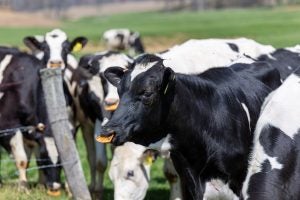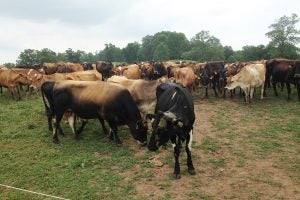The headline literally screamed off my phone’s screen: “U.S. EPA: OHIO FACTORY FARM PERMITS ARE ILLEGAL.”
What the heck? I receive a lot of news releases, but this one certainly caught my attention. It arrived in my inbox with a logo identifying its source as Toledo-based Lake Erie Advocates, whatever that is. The subheading boldly claimed: “Citizens win two-decades fight, call on Governor DeWine to terminate illegal CAFO permits, issue moratorium on new ones.”
The news release celebrated a major legal and legislative win by Vickie and Larry Askins of Cygnet, Ohio. The couple’s victory came 18 years after complaints, appeals, and lawsuits against what Larry described as a “rotten” scheme by the Ohio Department of Agriculture to promote factory farms over clean water for Ohioans. The rest of the release was a mismatch of out-of-context quotes, not-quite-accurate legal analysis, and the casual usage of scary terms like “factory farms.”
It ended with a plea for citizens to call Ohio’s governor and demand the termination of “illegal permits,” along with a moratorium on issuing new ones.

On the face of it, this seemed like a really big deal. What did it mean for the farmers that received permits previously? What about those seeking a permit? And how would this impact the future of animal agriculture in Ohio? Amid all the confusion, I was confident about one thing: This was going to blow up on social media. So I waited … and waited … and nothing ever came of it. It was eerily silent.
And then I investigated further and found the rest of the story …
ODA v. Ohio EPA
As with most issues, the devil in this saga has a lot of history and context that matters (and I’ll attempt to make this as digestible as possible). Farmers hoping to run a livestock operation in Ohio are required to obtain two permits. Since 2002, the ODA oversees the state-based program for concentrated animal feeding facilities (CAFFs). The permit has two components referred to as a permit to install and a permit to operate. A very high overview is that the permits regulate the way the farm is designed and built, and require that the farm has best management practices in place for the control of manure and pests.
Farmers also have to obtain a NPDES permit, which is handled through the Ohio Environmental Protection Agency. Its requirements are governed by the federal Clean Water Act, giving the U.S. EPA authority to oversee these permits. But in most states, including Ohio, the EPA has delegated that authority to a state-based agency. In this case, that’s the Ohio EPA.

If that all seems confusing, then you probably understand why the Ohio legislature passed legislation aiming to streamline the process. The law proposed that the ODA should oversee both permits — the CAFF permits and the NPDES permit. After all, it does seem redundant to have two separate agencies working on the same project, not to mention the difficulties it causes to those applying for a permit.
ODA easily took over the CAFF permits because it’s based on state law and the legislature changed the law to allow it. But transferring the NPDES permits to ODA was a bit harder because the U.S. EPA had to agree to the new delegation. Following the new legislation, the ODA and Ohio EPA entered into a memorandum outlining how the two agencies would work together on this issue as they waited for federal approval. That agreement specifically stated that Ohio EPA would retain the NPDES permitting until the U.S. EPA delegated authority for that program to the ODA.
The implementation
Here’s where things started to fall apart. By 2006, the ODA submitted its request for U.S. EPA’s authorization to handle the NPDES permits. Over the next 16 years, ODA and U.S. EPA went back and forth on the authorization. I’ll spare you the details (you can find a collection of the documents here), but suffice to say that it went back and forth for a variety of reasons (sometimes with years between steps, including the governor’s 2015 letter that the EPA responded to in 2019).
Meanwhile, the Askins were complicating matters by suing ODA, Ohio EPA, and the U.S. EPA over the entire scheme. When they filed their claims in 2014, the Askinses alleged that the ODA was issuing the NPDES permits. They came to that conclusion because the ODA copied the U.S. EPA’s requirements for manure management plans in preparation for the Clean Water Act authority designation. This allowed farmers to submit an identical plan to the ODA and Ohio EPA to obtain the required permits from both agencies. The Askinses assumed the Ohio EPA’s involvement was just for show and that the ODA was really issuing the NPDES permits.

But the federal district court wasn’t buying it. Just because the state agencies were coordinating and streamlining the process didn’t mean that they were doing anything wrong. The ODA issued the state permits, and the Ohio EPA issued the NPDES permits. The arrangement was consistent with state and federal law. The court entered a judgment against the Askinses.
The latest
So what prompted Lake Erie Advocates to issue a news release with that audacious headline? After years of not making any progress, the U.S. EPA has declined the transfer. The ODA won’t get authority from the U.S. EPA to issue the NPDES permits.
But that’s not because they weren’t equipped to handle it or did anything wrong. Rather it seems like Ohio just lost interest in the project. The Ohio Attorney General discovered that some state statutes would have to be amended to comply with the Clean Water Act; the legislature never made those changes. The funding for completing the transition dried up. And the ODA failed to respond to the U.S. EPA’s last two letters about required changes to the program.
So the U.S. EPA sent one final letter to the ODA and Ohio’s governor. It informed the ODA that it was closing the file and denying the delegation request, because it felt that further work on the project was unlikely given the circumstances. Yet the letter clearly said that the U.S. EPA was not foreclosing the possibility of given the Clean Water Act permitting to ODA; it just needed to reapply.
About that news release
Tl;dr: the news release was a complete fabrication. The EPA never declared “factory farming” permits illegal. The agency didn’t even say the ODA did anything wrong — and it wasn’t because it was never issuing the permits. The U.S. EPA simply closed its file on transferring authority from the Ohio EPA to the ODA, and invited the ODA to apply again if it wanted to. Despite their boasting, the Askinses didn’t win anything.
So why send the news release? Because organizations that rely on membership to support and fund their endeavors need big wins. They need to occasionally boost morale and encourage members to continue donating their time, talent, and treasures. And quite frankly, no one wants to admit that their decades-long battle was entirely pointless.
No worries. CAFOs (which aren’t actually the spawns of Satan) aren’t canceled in Ohio. This is just another example of disinformation.
Amanda Zaluckyj blogs under the name The Farmer’s Daughter USA. Her goal is to promote farmers and tackle the misinformation swirling around the U.S. food industry.



